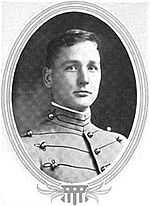Thomas B. Larkin
| Thomas B. Larkin | |
|---|---|
 Major General Thomas B. larkin | |
| Born |
12 December 1890 Louisburg, Wisconsin |
| Died | 17 October 1968 |
| Allegiance |
|
| Service/branch |
|
| Rank |
|
| Commands held |
Services of Supply, North African Theater of Operations Southern Line of Communications, European Theater of Operations Quartermaster Corps |
| Awards |
Distinguished Service Medal Silver Star Legion of Merit Bronze Star |
Lieutenant General Thomas Bernard Larkin (15 December 1890 – 17 October 1968) was a military officer who served as the 32nd Quartermaster General of the United States Army.
Early life

Larkin was born in Louisburg, Wisconsin and attended the Gonzaga University in Spokane, Washington. In 1915 he graduated from the US Military Academy at West Point ("the class the stars fell on") and was sent to Mexico in 1916 with the 2nd Engineers. After returning to the US he graduated in 1917 from the Engineer School at Washington Barracks, Washington, D.C. and in December was sent to France. He was awarded the Silver Star for his reconnaissance efforts during the Second Battle of the Marne during July 1918.
From 1921-1923 he served as the Assistant Military Attache for the American Embassy in Tokyo, Japan. In 1927 he graduated from the Army Industrial College; in 1929 from the Command and General Staff School at Fort Leavenworth, Kansas; and in 1938 from the Army War College.
Marriage and children
Larkin would marry Mary Irwin. She was the daughter of William, a United States Navy Commander, and Elizabeth Irwin. One of their sons, Harrison S. Larkin, was a First Lieutenant in the United States Air Force and was killed when his plane crashed on April 28, 1950.[1] The Larkin Conference Center at Fort Lee was named for Lieutenant Larkin. Another son, Thomas B. Larkin, Jr., was a Lieutenant in the United States Navy. All four Larkins, as well as the Irwins, are buried at Arlington National Cemetery.
Through the Irwins, Larkin was also a relative of Rear Admiral Harold Percival Norton, also buried at Arlington.
Military career
Larkin served a tour of duty in the Panama Canal Zone as Supervisory Engineer in charge of Third Locks Project, and as Special Assistant to the Governor of the Canal Zone in charge of special civil defense.
In February 1943 he became Commanding General for Services of Supply in the North African Theatre, and later Commander for the Communications Zone in North Africa. For his efforts in supplying the combat troops during the Tunisian Campaign he was awarded the Distinguished Service Medal in June 1943. He was also awarded an Oak Leaf Cluster to the Distinguished Service Medal in November 1944 for his role in planning the invasion of southern France and support of the 5th Army in Italy.
On February 1, 1946 he became Quartermaster General of the US Army, serving in this position until March 20, 1949.[2] He retired with grade of lieutenant general in 1952.
Awards and decorations
Larkin was the recipient of numerous awards including the Distinguished Service Medal with two Oak Leaf Clusters, Silver Star, Legion of Merit, Bronze Star, Mexican Campaign Medal, World War I Victory Medal, World War I Occupation Medal, World War II Victory Medal, American Campaign Medal; European, African, Middle East Campaign Medal; American Defense Medal, and World War II Occupation Medal.
Foreign decorations: French Croix de Guerre with Palm, the Brazilian Order of Military Merit, the Order of the Crown of Italy (Grand Order), the British Order of the Bath Companion, and the Polish Gold Cross with Sword.
References
- ↑ http://www.arlingtoncemetery.net/hslarkin.htm
- ↑ "From Root to McNamara, Army Organization and Administration", Center of Military History, 1975
External links
- Papers of Thomas B. Larkin, Dwight D. Eisenhower Presidential Library
- Arlington National Cemetery
- Biography, US Army Quartermaster Foundation
|